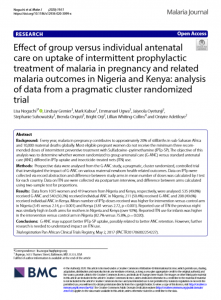
Background
Every year, malaria in pregnancy contributes to approximately 20% of stillbirths in sub-Saharan Africa and 10,000 maternal deaths globally. Most eligible pregnant women do not receive the minimum three recommended doses of intermittent preventive treatment with Sulfadoxine–pyrimethamine (IPTp-SP). The objective of this analysis was to determine whether women randomized to group antenatal care (G-ANC) versus standard antenatal care (ANC) differed in IPTp uptake and insecticide-treated nets (ITN) use.
Methods
Prospective data were analysed from the G-ANC study, a pragmatic, cluster randomized, controlled trial that investigated the impact of G-ANC on various maternal newborn health-related outcomes. Data on IPTp were collected via record abstraction and difference between study arms in mean number of doses was calculated by t test for each country. Data on ITN use were collected via postpartum interview, and difference between arms calculated using two-sample test for proportions.
Results
Data from 1075 women and 419 women from Nigeria and Kenya, respectively, were analysed: 535 (49.8%) received G-ANC and 540 (50.2%) received individual ANC in Nigeria; 211 (50.4%) received G-ANC and 208 (49.6%) received individual ANC in Kenya. Mean number of IPTp doses received was higher for intervention versus control arm in Nigeria (3.45 versus 2.14, p < 0.001) and Kenya (3.81 versus 2.72, p < 0.001). Reported use of ITN the previous night was similarly high in both arms for mothers in Nigeria and Kenya (over 92%). Reported ITN use for infants was higher in the intervention versus control arm in Nigeria (82.7% versus 75.8%, p = 0.020).
Conclusions
G-ANC may support better IPTp-SP uptake, possibly related to better ANC retention. However, further research is needed to understand impact on ITN use.